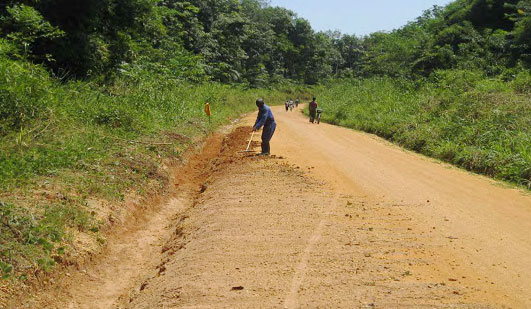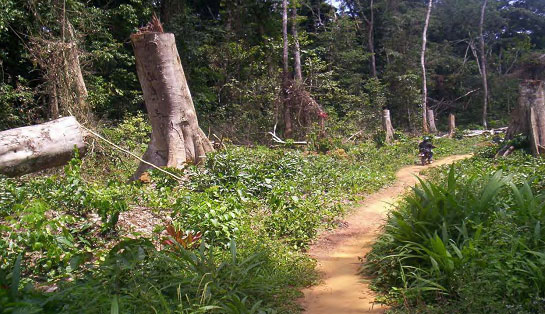A number of you have asked me in comments on my blog about how we involve local communities in our roads programmes. And I'm overdue to tell you about my recent field visit, which I mentioned in my blog on DFID's Bilateral Aid Review announcement. These two issues fit together neatly.
My visit was to a road between Kisangani – the town at the famous 'bend in the river' which VS Naipaul wrote about in his book of the same name, and that was Colonel Kurtz's Inner Station in Conrad's Heart of Darkness – and Ubundu, 128km to the south.

The road was important before the conflict because the Congo river is impassable along this stretch, due to a series of treacherous cataracts. But with no finance in the government coffers to maintain the road, and with security in the area very low during the war, the rainforest quickly ate the road back up. Only bikes or pedestrians could make it the length of the road, and a full rehabilitation was needed to help reinvigorate the local economy and ensure people could access basic health and education services.
To rehabilitate the road, the people who lived in the area were asked about their needs and the impact a new road would have on their lives. A system of local labour-based construction was used in the first phase of the project, providing a large number of days of labour for the local economy.
As I mentioned in my last post, our programmes include targets on employing women from the local community. And in eastern DR Congo, where the peace remains fragile, we are also employing ex-combatants to ensure they have incomes and therefore less of a reason to return to fighting. Where there are local indigenous populations and forest dwellers, our programmes take their needs into account as they are designed. And – given my dual role on infrastructure and environment – we take environmental issues around road-building very seriously indeed. But that will be the subject of a future post.

To return to my first DR Congo field visit, the road had been re-opened in September 2010. So we were able to drive the length of a brand new – albeit unpaved – road.
We learnt huge amounts during the course of this project – not least how crucial an effective system for financing and implementing maintenance is. I'll write more about that in future posts too, but the key point here is that the system we're using to ensure this road stays open also involves the local communities. Using an old colonial – but very effective – system, the DR Congo's national road fund finances 'cantonniers', or road maintenance workers, who each maintain 1km of the road and are paid if they deliver satisfactory results. This ensures not only new employment opportunities, but also that the communities benefiting from the road have a stake in its upkeep.

4 comments
Comment by Ajmir Imtiaz posted on
Dear Vicky,
Thank you for sharing development stories.
best,
Ajmir
Kabul, Afghanistan
Comment by Lydia Butler posted on
Hi Vicky,
Thank you so much for writing this blog! I find it absolutely fascinating to read about development 'on the ground'. In September I'll be starting a degree in Human Geography, after which I would love to begin a job like yours- I love travelling, but find that experiences are even better when you are giving something positive back to the area.
In the mean time, I'm interested in getting some work experience with DFID, and wondered whether you'd be able to point me in the right direction!
Thank you!
Regards,
Lydia
Devon, UK
Comment by Ramsey posted on
Hi,
This is a common problem in Africa where the useful life of rural low volume (traffic) roads are dictated by environmental factors rather than traffic loading. And the deterioration of the roads is not therefore linear but subject to the characteristics of the road : eg steep, in a sag, etc...and is not therefore a linear deterioration along the road length.
An understanding of this can assist in stretching budgets further - homing in on problematic areas and elevating them to surfaced roads with unsurfaced inbetween is an example.
Regards
Ramsey
Comment by Rachel Kasumba posted on
The practice of involving the local communities in whatever developmental projects that donors, private sector, or government are tying to do is always the best way to go. Only then will the communities feel that they have a stake and a responsibility to ensure the success of their future. Employment opportunities and accountability should go hand-in-hand.